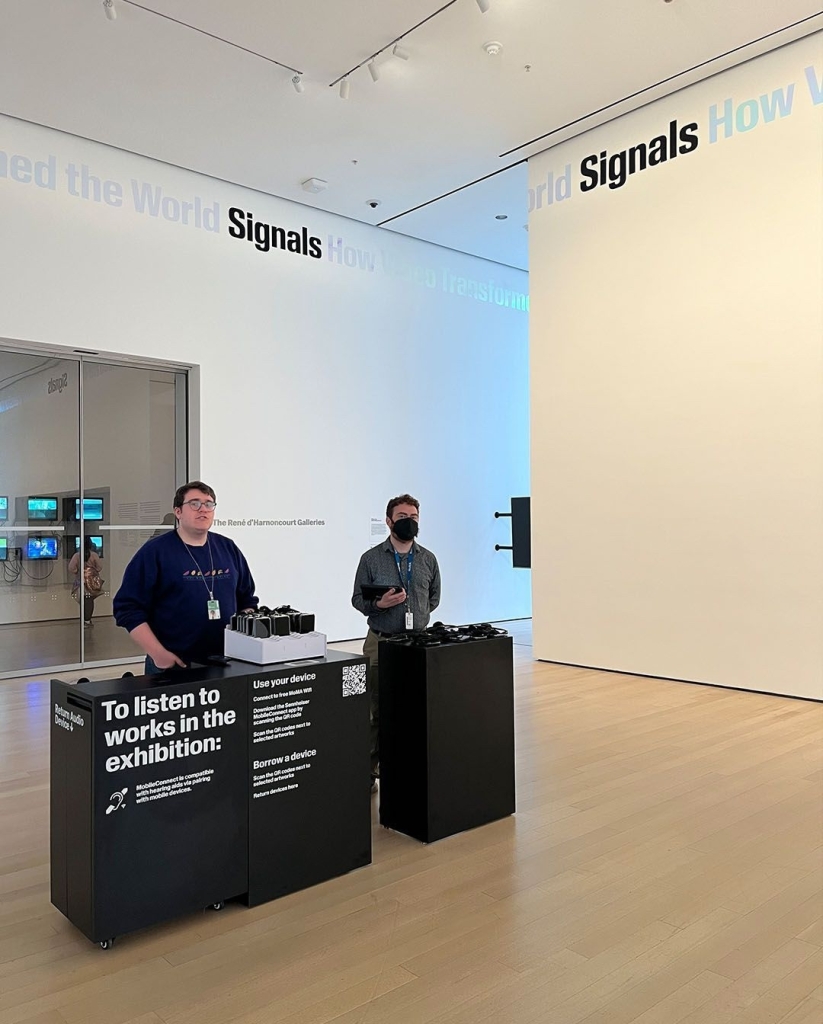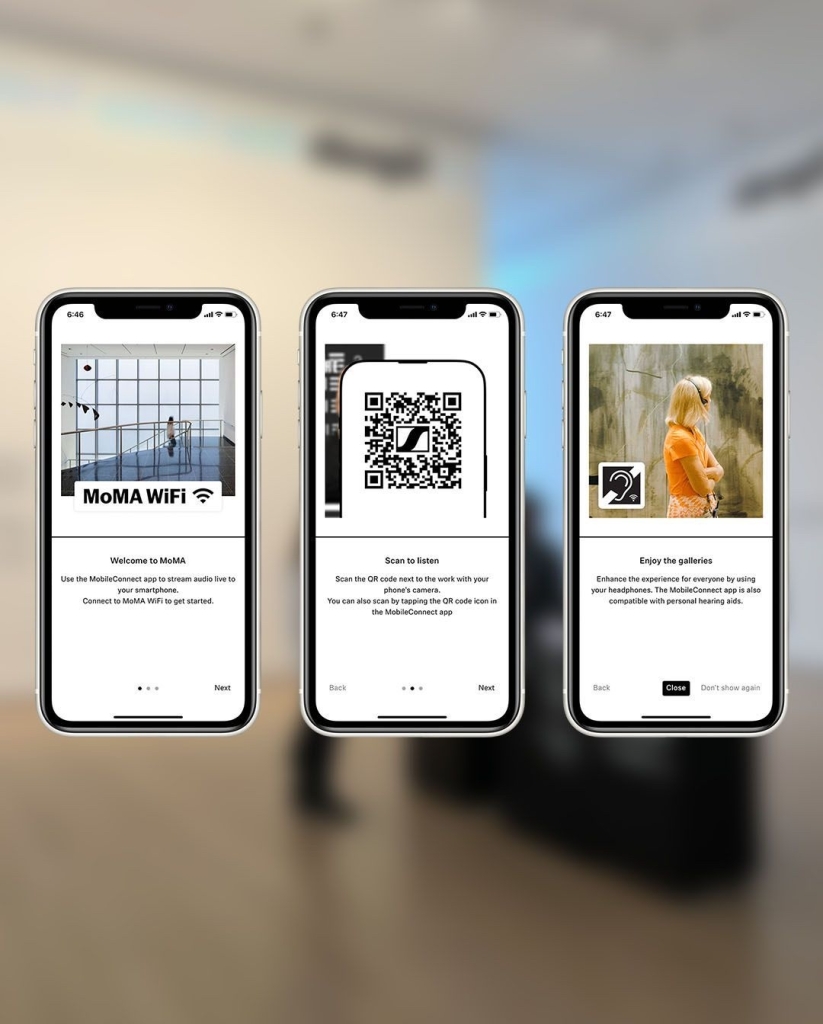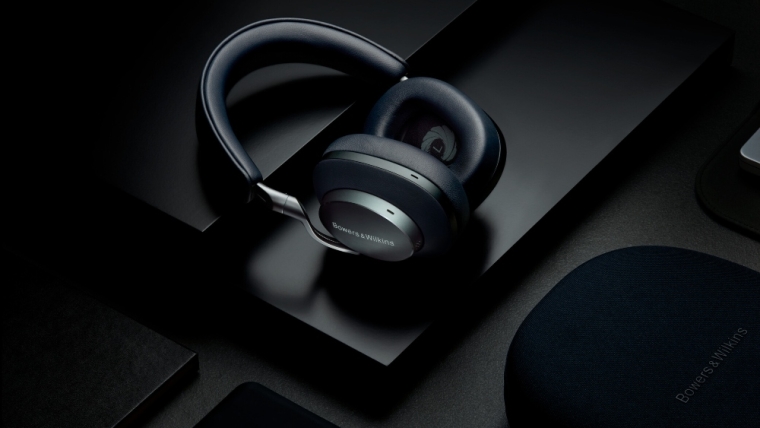
In the heart of Midtown Manhattan lies the Museum of Modern Art (MoMA), an institution that has become recognized as one of the most famous museums in the world for modern and contemporary art. The museum recently featured an exhibit titled “Signals: How Video Transformed the World,” in collaboration with professional audio technology company Sennheiser.
The exhibit was on display from March 5 until July 8, 2023. It revolved around video art, an art form that emerged in the late 1960s as consumer technology expanded in technological capability and influence on the average person. The exhibition aimed to examine how “artists have posed video as an agent of global change—from televised revolution to electronic democracy,” according to the exhibition’s website. Because the exhibition centered on video, the audio qualities had to be honored as much as the visual aspect.
Enter Sennheiser, a company well-acquainted with the technology of sound, and equally committed to ensuring an artist’s vision and artistic integrity are maintained with its products. Sennheiser was approached by MoMA to design a customized version of Sennheiser’s MobileConnect app, an audio accessibility solution that streams audio over Wi-Fi. The technology was then integrated into “Signals” to allow visitors to experience multiple audio works at once, all at their own pace.


A Brief Look into MoMA
The idea for MoMA was conceived by socialite and philanthropist Abby Aldrich Rockefeller along with her friends Lillie P. Bliss and Mary Quinn Sullivan, both art collectors. The impetus was a desire “to challenge the conservative policies of traditional museums and to establish an institution devoted exclusively to modern art,” according to MoMa.org. The museum opened in 1929 and became the premier museum dedicated exclusively to modern art in the nation. MoMA was initially gifted with just eight prints and one drawing.
The museum, which was renovated in 2019, has a footprint of 708,000 square feet. The magnitude of the museum space correlates to its influence and impact on visitors. The Art Newspaper reported that 1,160,686 people visited MoMA in 2021 and it was the 15th most visited art museum worldwide. Approximately 200,000 architectural works, paintings, sculptures, drawings, prints, photographs, media, and performance art pieces are in its collection, with works from Vincent Van Gogh, Frida Kahlo, Jasper Johns, Georgia O’Keeffe, Salvador Dalí, Andy Warhol, and Pablo Picasso adorning the walls. MoMA’s library is also gargantuan, containing over 320,000 items such as artists’ books, periodicals, and detailed individual files on over 90,000 artists.


Sennheiser & MoMA: A Modern Match for the Ages
The sheer size and volume of the museum space unsurprisingly allow sound to be carried with relative ease. The lobby is the loudest, naturally, with the gallery and exhibition areas a bit more muted. Every footstep and minute whisper can be heard in these spaces, which is what made “Signals” so intriguing as it was distinctly and purposefully loud; Not just because of the visitors milling about, viewing and commenting, but because of the art pieces themselves.
“Signals” housed over 70 media works from MoMA’s collection with many never before seen at the museum. Celebrated video artists Nam June Paik, Dara Birnbaum, John Akomfrah, Stan VanDerBeek, Sondra Perry, and Ming Wong were featured in the exhibition. The works were presented in “wildly varied formats, settings, and global reach, from closed-circuit surveillance to viral video, from large-scale installation to social networks” to showcase the wide range of forms video art can take. The exhibition was humming with the sounds of news clips, television shows, performance art, and historical footage presented from a variety of mediums such as a wall of televisions, projection screens, and even tablets.
The team behind “Signals” was careful to set up the exhibit so that no single work’s audio was overpowering the audio of another. With many sounds overlayed on one other in a defined space, it can be difficult for visitors, especially the deaf or hard-of-hearing visitors with assistive listening devices, to fully experience a work. As a result, the exhibition’s accessibility is impacted, which is where Sennheiser stepped in.
Sennheiser’s MobileConnect system offers an audio-accessible solution to connect speakers with audiences all through Wi-Fi. The system consists of three parts: a MobileConnect station, a smartphone MobileConnect app, and a MobileConnect manager that can be integrated into a facility’s Wi-Fi network. Users can download the app and connect to a nearby MobileConnect station which “receives and distributes low-latency audio between the presenter and up to 100 MobileConnect App-enabled smartphones,” according to Sennheiser.
“You can see [MoMA is] using it in a very intense application here,” said Josh Lefkowitz, East Coast Business Development Manager of Sennheiser, on the museum’s implementation of MobileConnect. We were standing in a section of the exhibition featuring the work “Good Morning Mr. Orwell” by Nam June Paik.
The 1984 piece was originally a live television broadcast in response to British author George Orwell’s bleak characterization of television in his 1948 novel, Nineteen Eighty-Four. The broadcast “features pop-music videos, boundary-breaking performances, video art, and dance, combining live and taped contributions by a variety of artists.” The piece was shown on four separate televisions in “Signals,” each depicting a different section of the work. It also featured external speakers, though it only played audio from one of the displays.
Lefkowitz likes the area with “Good Morning Mr. Orwell” the most out of the exhibit, describing it as “a great way of demonstrating what MobileConnect can do and can be.”
With such a setup portraying separate portions of an entire work, each with unique audio components, it can be difficult for a visitor to fully experience a piece. Sennheiser’s MobileConnect made this simple. Next to many of the pieces in the exhibition are plaques with QR codes that, once scanned through the MobileConnect app, connect the visitor to the work’s audio. “Even though they have their own audio coming from here, you can sync up to any one of these monitors at any time,” noted Lefkowitz. “In an instance like this, where you have all these different audio-immersive exhibits and visual items, it definitely helps separate the individual things so you can have your own experience.”
According to Sennheiser, MoMA estimates that with MobileConnect, over 95 percent of the artworks in “Signals” can be fully accessible to hard-of-hearing visitors. Lefkowitz and Communications Manager of Sennheiser Daniella Kohan added that MobileConnect is “true inclusion.”
It offers a modern assistive listening solution via a smartphone either brought by the user or provided by MoMA, which makes MobileConnect ADA-compliant, according to Lefkowitz. “Where previous areas would have had an assistive listening user that has to stand in a certain area or has to use an almost archaic-looking device” to experience an exhibit, visitors can use their own smartphones and personal listening devices, or those provided by MoMA, Lefkowitz elaborated.
The app is easy to navigate, and MoMA has staff trained to help visitors access the system. “When you’re having this many visitors come through every day, you need something that is super intuitive for whomever your customers are,” said Kohan. “And everyone can use it.”


Getting Hands-On
Though I had come prepared with the MobileConnect app downloaded on my phone and my own earphones, MoMA provided me with an Android device and headphones, the custom MobileConnect app already installed. I experienced the exhibit primarily using this set. As Lefkowitz and Kohan said, the app was easy to use and super intuitive. Once you scan the QR code next to a piece, the app immediately accesses the dedicated channel and begins playing audio as it is synchronized with the video. The audio was crisp and clear, heightening the immersive experience for each of the video art pieces.
MobileConnect has commonly been used in places of higher education and on museum tours. MoMA has used MobileConnect previously in other exhibitions, and currently has approximately 40 stations throughout the museum. However, “Signals” was the first public-use case for a custom version of the MobileConnect app.
As Business Development Manager, Lefkowitz was the liaison between MoMA and Sennheiser. The project went through several rounds of development and involved Sennheiser’s product development and streaming services team, who tried to hit MoMA’s key benchmarks and milestones to achieve “Signals.” MoMA purchased the MobileConnect system through one of Sennheiser’s authorized dealers and handled the installation of the exhibit from there. “It was a pretty smooth partnership,” said Kohan. “I would say it’s a natural fit for them. For us, it was a really natural install.”
The main challenge of outfitting “Signals” with MobileConnect was the amount of MobileConnect stations being used simultaneously in a small area. Each station has two channels of audio that send 100 streams over Wi-Fi, which is also the number of listeners that can listen to that station. Each channel can be dedicated to a specific audio stream, such as music or language.
On the MobileConnect app and in the exhibition, each QR code corresponds to a channel. Paik’s piece was made up of four displays each with a QR code, meaning the entire work required two MobileConnect stations. The rest of the room housed six more MobileConnect stations. Lefkowitz stated that for an exhibition of this size to work, there had to be a “robust Wi-Fi network” that was also secure enough for each channel to stream over. Luckily, MoMA provided one.
MobileConnect suited the busy environment of “Signals” and MoMA, allowing me to explore the exhibition in depth and at my own pace. This was a chief value communicated by Sennheiser, as well. “This is super nice because you can just go and see what screen doesn’t have that many visitors at it, scan the QR code, and bounce around at your leisure without feeling like you’re missing out on anything,” said Kohan.
After finishing with Lefkowitz and Kohan, I spent around two hours exploring the rest of the exhibit using the custom MoMA MobileConnect app. As I was roaming through “Signals,” I noticed other visitors using MobileConnect, some with the devices provided by MoMA and others with their own. Scanning each work’s QR code and being able to listen to the audio from each was rewarding. It allowed me to gain a deeper understanding of each of the works and truly made the experience of “Signals” special.



